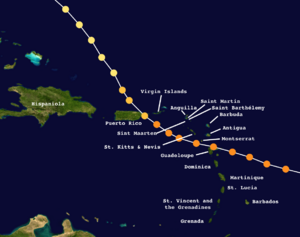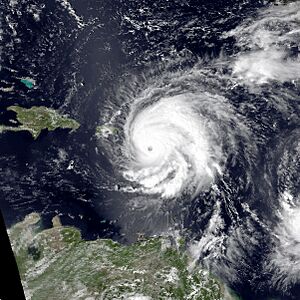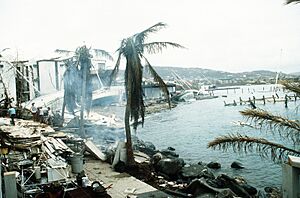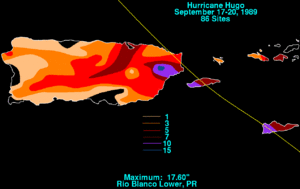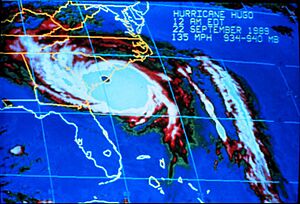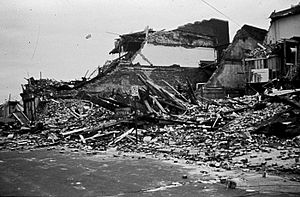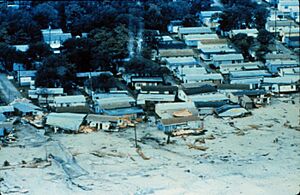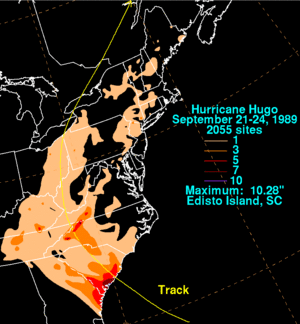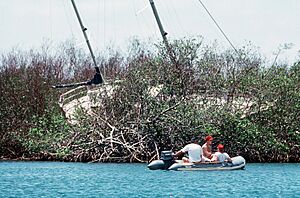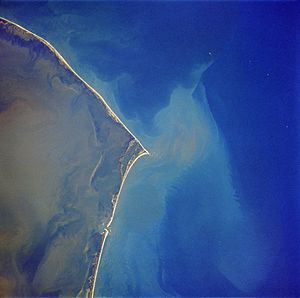Hurricane Hugo facts for kids
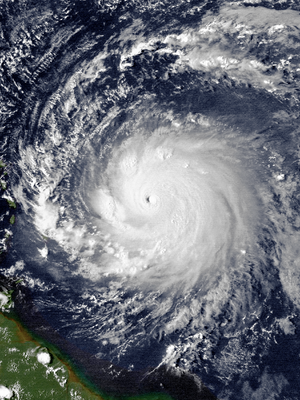
Hugo at peak intensity east of the Lesser Antilles on September 15
|
|
| Meteorological history | |
|---|---|
| Formed | September 10, 1989 |
| Extratropical | September 23, 1989 |
| Dissipated | September 25, 1989 |
| Category 5 tropical cyclone | |
| 1-minute sustained (SSHWS/NWS) | |
| Highest winds | 160 mph (260 km/h) |
| Lowest pressure | 918 mbar (hPa); 27.11 inHg |
| Overall effects | |
| Fatalities | 67 direct, 40 indirect (107 total) |
| Damage | $11 billion (1989 USD) |
| Areas affected |
|
|
Part of the 1989 Atlantic hurricane season |
|
Hurricane Hugo was a very strong tropical cyclone that caused a lot of damage. It hit the northeastern Caribbean and the Southeastern United States in September 1989. Hugo started as a group of thunderstorms near Cape Verde on September 10, 1989.
It grew stronger as it moved west across the Atlantic Ocean. By September 13, it became a hurricane. On September 15, Hugo reached its strongest point. Its winds were about 160 mph (260 km/h). This made it a Category 5 hurricane.
Between September 17 and 21, Hugo hit land in several places. These included Guadeloupe, Saint Croix, Puerto Rico, and South Carolina. It was still a very strong hurricane when it hit these areas. The storm became weaker as it moved inland. It then turned into a different type of storm by September 23. Hugo was last seen in the far northern Atlantic on September 25.
Hugo caused a lot of destruction. It led to 67 direct deaths and about $11 billion in damage. At that time, it was the most expensive hurricane ever recorded. Guadeloupe was hit very hard in the Leeward Islands. Three thousand homes lost their roofs. This meant 35,000 people had to leave their homes.
Montserrat also suffered greatly. It was the most costly hurricane for the island. Its entire power system was knocked out. Ninety percent of homes on Montserrat had major roof damage. Hugo also caused over $1 billion in damage in the Virgin Islands and Puerto Rico. Winds reached 168 mph (270 km/h) in Saint Croix. Over 90 percent of buildings there were damaged. Three people died on the island.
In Puerto Rico, there was widespread damage. Many people lost power and water. Eight people died in Puerto Rico. Nearly 28,000 people lost their homes. In the United States, coastal South Carolina saw record-high storm surge. The water rose over 20 feet (6.1 m) near McClellanville, South Carolina. This surge and strong winds damaged many buildings. It also caused 13 deaths in South Carolina. Flooding and wind damage continued across the Eastern United States into Eastern Canada.
Hugo also caused huge damage to farms and nature. Guadeloupe lost all its banana crops. Most of its coconut palms and sugar cane crops were also destroyed. Bat populations in Montserrat dropped a lot due to habitat loss. Bird species in the eastern Caribbean also suffered. Coastal birds in South Carolina had to move far inland. Forests between South Carolina and Virginia were heavily damaged. In South Carolina alone, timber losses were about $1.04 billion.
Hugo was the strongest hurricane to hit the northeastern Caribbean since Hurricane David in 1979. It was also the strongest to hit the continental U.S. since Hurricane Camille in 1969. Because of the huge impact, the name Hugo was removed from the list of hurricane names.
Contents
Hurricane Hugo's Impact
| Country | Deaths | Damage |
|---|---|---|
| Antigua and Barbuda | 2 | $200 million |
| British Virgin Islands | — | $50 million |
| Dominica | — | $20 million |
| Guadeloupe | 11 | $880 million |
| Montserrat | 10 | $260 million |
| Netherlands Antilles | 11 | $50 million |
| Puerto Rico | 8 | $2 billion |
| St. Kitts and Nevis | 1 | $46 million |
| Contiguous United States | 21 | $7 billion |
| U.S. Virgin Islands | 3 | $500 million |
Caribbean Islands Hit by Hugo
Hugo was the strongest storm in the northeastern Caribbean since Hurricane David in 1979. The storm surge caused coastal water levels to rise 3–4 feet (0.91–1.22 m) above normal tides. This happened along Saint Croix and eastern Puerto Rico. Rainfall on the Caribbean islands was usually between 5–10 inches (130–250 mm). At least 28 people died in the eastern Caribbean. Over 100,000 people may have lost their homes.
Guadeloupe and Montserrat were the most affected islands. They had over $1 billion in damage and 21 deaths. Other islands also had damage. In Antigua, there was a lot of flooding. Power went out after utility poles fell. Two people died and 181 were injured. About 509 people lost their homes. Damage to 1,500 homes was partial, and 106 homes were totally lost. Many fishing boats were also damaged.
In Saint Kitts and Nevis, Hugo caused $46 million in damage. This mostly affected buildings near the shore and crops. Homes, government buildings, and trees were damaged. One-fifth of the country's people lost their homes. Everyone lost power and water. Ninety percent of people in Nevis lost their homes. One person died there.
Dominica was the most affected among the Windward Islands. Hugo destroyed 80 percent of the island's banana crop. It also cut off water supplies. Coastal roads were damaged by rough seas. Landslides cut off towns for many days. The damage in Dominica was $20 million. In Martinique, winds reached 60 mph (97 km/h). Some banana farms were damaged, but overall wind damage was small. Heavy rains caused some mudslides. Rough seas flooded parts of Fort-de-France.
Hugo moved near the Virgin Islands and hit Puerto Rico twice. This caused a lot of damage. Damage estimates include over $50 million for the British Virgin Islands and Netherlands Antilles. Puerto Rico had $2 billion in damage, and Saint Croix had $500 million. In Sint Maarten, winds unroofed homes and knocked down trees and power lines. About 25 sailboats were badly damaged.
Sint Eustatius and Saba lost much of their plants. Many homes, piers, and public buildings were severely damaged. Eleven people died in the Netherlands Antilles. The British Virgin Islands had over $50 million in damage. At least half of their farms were destroyed. About 30 percent of homes lost their roofs. Power outages affected the British Virgin Islands. On Tortola, many homes were destroyed. Hugo also caused widespread power outages in the Dominican Republic.
Hugo's Impact on Guadeloupe
Guadeloupe was hit hardest in the Leeward Islands. Hugo hit the island on September 17 as a Category 4 hurricane. Winds were about 140 mph (230 km/h). This made Hugo the strongest hurricane to hit Guadeloupe since 1928. Wind gusts may have reached 200 mph (320 km/h). Hugo's effects lasted about 12 hours in Guadeloupe. Rainfall totals ranged from 3.1 inches (79 mm) to 13.8 inches (350 mm). Storm surge raised the sea level by 8 to 10 feet (2.4 to 3.0 m).
The storm knocked out phone and power lines across Guadeloupe. The island of La Désirade lost all contact with the outside world. Three thousand homes, mostly small wooden houses, lost their roofs. About half of Pointe-a-Pitre, the largest city, was destroyed. The control tower at the airport was wrecked. Lower parts of Sainte-Rose were flooded. Saint-François was largely destroyed. Many tourist hotels were badly damaged.
Two people died in Le Moule. Hugo ruined all of Guadeloupe's banana crop. Most coconut palms and sugar cane crops were also destroyed. The storm also wiped out most of the island's fishing boats. Many ships were pushed onto land by 24 foot (7.3 m) waves. Debris blocked 70 percent of roads. There were 11 deaths in Guadeloupe. Another 107 people were injured. About 35,000 people lost their homes. The damage in Guadeloupe was $880 million.
Montserrat's Hurricane Experience
Montserrat was hit by the strongest part of Hugo's eye on September 17. Winds were about 140 mph (230 km/h). Wind gusts might have reached 240 mph (390 km/h). The hurricane caused heavy damage for 14 hours. Hugo was the most expensive hurricane in Montserrat's history, causing $260 million in damage. Whole villages were destroyed. Plants and trees were stripped bare.
Most houses on the island were destroyed or badly damaged. This left 11,000 of Montserrat's 12,000 residents homeless. Almost every building had some damage. Half of all buildings were severely damaged. About 90 percent of homes lost most or all of their roofs. Hotels also suffered heavy damage.
All government buildings and schools were affected. The main government building lost much of its roof. Air traffic control at the airport was destroyed. The 180 foot (55 m) stone jetty at Plymouth was destroyed by 20 foot (6.1 m) waves. The island's power system was completely broken. All major communication facilities were destroyed. Heavy rainfall caused mudslides. Radio and microwave towers on the mountain fell down. Strong winds also knocked down thousands of trees and power poles. Ten people died in Montserrat and 89 were injured.
United States Impact
Hugo was the most expensive hurricane in U.S. history at the time. It caused about $8 billion in damage. This was more than three times the damage from Hurricane Frederic. Hugo was also the most powerful storm to hit the U.S. since Hurricane Camille in 1969.
Hugo caused rain, storm surge, and strong winds. There were also reports of tornadoes in South Carolina and North Carolina. It was hard to tell tornado damage from hurricane wind damage. Twenty-six people died directly from Hugo's weather in the U.S. South Carolina had the most deaths, with 13. The American Red Cross reported 70 deaths in the Carolinas, Puerto Rico, and the U.S. Virgin Islands.
More than 200,000 families nationwide had their homes damaged or destroyed. This included 129,687 families in the Carolinas. Another 87,700 families were affected in Puerto Rico and the U.S. Virgin Islands.
U.S. Virgin Islands Hit Hard
Hugo was the first major hurricane to hit the Virgin Islands and Puerto Rico since Hurricane Betsy in 1956. Hugo moved through the Virgin Islands on September 18. It destroyed 30 percent of homes there. Generally, 6–9 inches (150–230 mm) of rain fell.
The eye of Hugo passed over Saint Croix at 2:00 a.m. AST on September 18. Hurricane-force winds lasted for a very long time. Peak winds were about 140 mph (230 km/h), making it a Category 4 hurricane. The winds tore roofs off homes and knocked out power in Saint Croix and Saint Thomas. Unofficial reports said Saint Croix had gusts over 200 mph (320 km/h).
Hugo killed 3 people and left 3,500 homeless on Saint Croix. Damage to private and government property was over $500 million. Electricity, power, and water services were cut off. More than 90 percent of buildings were damaged. Plants and trees were stripped bare. Seventy percent of buildings were destroyed. Many neighborhoods were completely ruined.
The heaviest damage on Saint Croix was along its northern coast. The sloping land near Christiansted made the winds even stronger. Stores in Christiansted were damaged. Power and water plants were disabled. An oil spill happened in Christiansted harbor. The Hovensa oil refinery was damaged. The airport's control tower and planes were badly damaged. Less severe damage happened in southwestern Saint Croix. Rough waves damaged the city pier in Frederiksted.
Saint Thomas also had hurricane-force winds. Homes were unroofed and boats were damaged. Damage was less severe than on Saint Croix. A TV station's antenna and transmitter were destroyed.
Puerto Rico's Struggle with Hugo
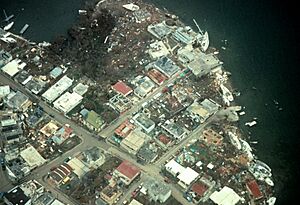
Two people drowned in Puerto Rico during Hugo. Six others died in Guayama. Losses in Puerto Rico were estimated at $2 billion. Property damage was $900 million, and crop damage was $100 million. Hugo hit Puerto Rico twice on September 18. It hit Vieques and Fajardo as a strong Category 3 hurricane. Winds were about 125 mph (201 km/h). A ship in Culebra recorded a wind gust of 170 mph (270 km/h).
The strongest wind on Puerto Rico's main island was 104 mph (167 km/h). It had gusts up to 120 mph (190 km/h). The heaviest rain was in the northeastern part of the island. A peak of 17.60 inches (447 mm) of rain fell. Flooding was mostly in the northeast and San Juan. Two rivers set new records for water flow. Flash floods happened near other rivers. Floods affected areas near Luqillo and low parts of San Juan. Two hundred landslides occurred.
Culebra and Vieques, two small islands, were hit harder than the main island. Culebra had stronger winds and more damage. Eighty percent of homes in Culebra were destroyed. Many boats were damaged. On Vieques, winds gusted up to 132 mph (212 km/h). The roof of a baseball stadium was torn off. A thousand families in Vieques lost their homes.
The worst damage on Puerto Rico's main island was along the northeast coast. This was in Fajardo and Luquillo. Storm surge reached 8 feet (2.4 m) in Luquillo. Waves were at least 10 feet (3.0 m) high. Two ferries were pushed onto land in Fajardo. Boats had over $50 million in losses. Marinas had $25 million in damage. An aerial survey found that winds unroofed 80 percent of homes between San Juan and Fajardo.
The Naval Station took heavy damage and lost power and water. Almost every building was damaged. High waves along San Juan's coast destroyed walls and sidewalks. A mobile home park in Loíza was wiped out. Winds overturned cars and knocked down trees and streetlights. Fifty airplanes were destroyed at the airport. Repairs to the airport cost $20 million.
Eighty percent of Puerto Rico lost power. Power and water in San Juan were cut for over a week. At Carraízo Dam, San Juan's main water supplier, electric motors were flooded. This stopped water distribution. The lake behind the dam rose. Floodgates could not open due to power outages. Poor maintenance made the dam vulnerable. Power systems in 35 towns were badly damaged. A destroyed antenna cut off communication to Vieques and Culebra. Fallen power lines and damaged homes stranded the mayor of Arroyo. Damage to highways was $40 million. Crops like bananas and coffee had widespread losses.
South Carolina's Devastation
The eye of Hugo hit South Carolina at Sullivan's Island at 12:00 a.m. EDT on September 22. Winds were about 140 mph (230 km/h). This made Hugo a Category 4 hurricane at landfall. It was the strongest hurricane to hit the U.S. in 20 years. A ship near Georgetown recorded 120 mph (190 km/h) winds. In downtown Charleston, winds were 87 mph (140 km/h) with gusts of 108 mph (174 km/h).
Hugo caused an 8 foot (2.4 m) storm surge in Charleston. Elsewhere, storm tides reached 20 feet (6.1 m). The highest surge was 20.2 feet (6.2 m) near McClellanville, South Carolina. This was the highest storm tide ever recorded on the U.S. East Coast. Between 3–8 inches (76–203 mm) of rain fell across South Carolina.
The South Carolina Electric and Gas Company called Hugo "the single greatest natural disaster ever to strike the state." It caused $5.9 billion in property damage. Hugo hit three major South Carolina cities. There were 35 deaths linked to Hugo in South Carolina. Manufacturers lost $158 million in factory damage. They also lost $750 million in inventory and income.
Hugo's storm surge destroyed barrier islands. Many homes on Wadmalaw Island and Johns Island were crushed by fallen trees. The Ben Sawyer Bridge to Sullivan's Island was badly damaged. Beachfront homes on Sullivan's Island were destroyed. Ships in Isle of Palms were piled up on the shore. Beach homes were moved 150 feet (46 m) off their foundations. In total, 60 homes were destroyed on Isle of Palms. Every building on Sullivan's Island and Isle of Palms was damaged. Storm surge tore up coastal roads. All coastal state parks, except two, were significantly damaged.
Charleston County was at the center of Hugo's damage. Near McClellanville, shrimp boats were pushed 0.5 miles (0.80 km) inland. A high school used as a shelter was flooded. The storm surge went up the Ashley, Cooper, and Santee rivers. This flooded low-lying areas 10 miles (16 km) upstream. One person died from the rising Cooper River. Seven to eight hundred boats were ruined. Hugo's surge flooded The Battery. It also flooded the first floors of homes in downtown Charleston. Eighty percent of roofs in the city were damaged. At least 3,200 historic buildings were damaged. Ninety-five percent of urban trees were lost. The Naval Weapons Station had $95–$100 million in damage. Two people died in Charleston when their homes collapsed.
The U.S. Route 17 bridge was destroyed by a 19.4 foot (5.9 m) storm tide. Huge losses of timber happened at Francis Marion National Forest. Seventy-five percent of marketable trees fell. Animals, including endangered species, died at Cape Romain National Wildlife Refuge.
Coastal damage was widespread beyond Charleston County. The waterfront in Georgetown was heavily damaged. One hundred fifty homes were destroyed. Major damage hit 350 homes. Minor damage affected another 500 homes. Farms and businesses around Georgetown had $10 million in damage. Few beachfront homes survived in Pawleys Island. Debris from destroyed homes piled up on streets. Hugo caused about $944 million in damage in Horry County.
Protective sand dunes were washed away. Beaches along 150 miles (240 km) of the Carolinas moved 50–200 feet (15–61 m) inland. Beaches in Garden City were eroded by a 13 foot (4.0 m) surge. Coastal homes were destroyed or washed inland. The administrator for Horry County said the city "for all practical purposes is gone." Severe beach erosion also happened in Myrtle Beach and North Myrtle Beach. Piers were heavily damaged. The pier at Sunset Beach was reduced to its supports. The Air Force Base had $2 million in damage.
Hugo's speed allowed strong winds to go far inland. This caused widespread wind damage across eastern South Carolina. Wind damage was "extensive" in 15 counties. Pine tree groves were destroyed. Many homes lost roofs. Cotton crops were damaged. Over one-third of all timber in the state was damaged. This was enough timber to build 660,000 homes. Hugo was the most significant forest disaster in South Carolina history. Across 23 counties, 4.4 million acres (1.8 million hectares) lost 6.6 million board feet (15,600 m3) of timber. This was three to four times the usual annual timber harvest. The lost timber was valued at $1.04 billion.
Downed trees and debris cut power lines. Most areas lost power. Three power plants were also disabled. Thirty-five municipalities lost power. The effects of Hugo were most deadly in Berkeley County, where eight people died. Over a thousand homes and apartments were destroyed. Seventy to eighty percent of the county's trees fell. Up to a quarter of York County's cotton crop was lost. Peach, sorghum, and soybean crops also suffered.
North Carolina's Inland Damage
In North Carolina, Hugo damaged 2,638 buildings and destroyed 205. The total damage was $1 billion. Losses to crops and animals were nearly $97 million. Seven people died in the state. Storm surge along the coast reached 9 feet (2.7 m). Three beach towns had $55 million in damage. At least 25 beachfront homes were hit. Another 100 buildings were threatened by coastal erosion.
Along parts of the coast, 50 feet (15 m) of beach eroded. This included sand dunes that were 7–8 feet (2.1–2.4 m) tall. Sixty percent of the sand dunes in Long Beach were gone. Several piers were destroyed.
Hugo's fast movement allowed strong winds to reach far inland. This caused widespread damage in western North Carolina. This area rarely sees tropical cyclone impacts. Hugo created a 50 mile (80 km) wide path of downed trees and power lines west of Charlotte. Hurricane-force wind gusts reached 200 miles (320 km) inland. The control tower at Charlotte Douglas International Airport recorded a 99 mph (159 km/h) gust. Windows were blown out of skyscrapers in Downtown Charlotte. A 400 foot (120 m) TV antenna collapsed. Many trees in Charlotte fell on homes and power lines. This caused long power outages for 85 percent of homes and businesses. Winds piled boats together and damaged thousands in Lake Norman. Wind damage in Mecklenburg County was over $500 million. Millions of trees fell across the Foothills and Piedmont. Some areas had no power for weeks.
Virginia's Encounter with Hugo
Parts of Southwest Virginia were also hit by Hugo's strong winds. Hugo passed through the state as a tropical storm. Gusts of 81 mph (130 km/h) were recorded. These were the fastest gusts measured in Virginia. Like in North Carolina, winds knocked down many trees. This caused widespread power outages and building damage. Tree debris blocked hundreds of roads. Damage occurred as far east as Interstate 95. The damage in Virginia was about $60 million. Six people died statewide.
Hugo's quick movement meant less rainfall. However, in southwestern Virginia and western North Carolina, the Appalachian Mountains caused heavier rain. This resulted in 6 inches (150 mm) of rain. While not enough for major river flooding, minor flooding affected mountainous areas. Highways in seven counties were flooded. A nursing home in Boone, North Carolina was evacuated due to a flash flood. In Burnsville, North Carolina, flooding forced 79 prisoners to evacuate.
Rainfall totals of 1–4 inches (25–102 mm) occurred throughout southwestern Virginia. A maximum of 6.5 inches (170 mm) fell in Hillsville, Virginia. Some low-lying areas and streams flooded. Flooding along the South Fork of the Roanoke River forced about 60 people to evacuate.
Other U.S. Areas Affected
Strong winds in Georgia knocked down trees in four counties. This damaged homes and power lines. About 50–75 trees fell around Savannah. Wind gusts reached 54 mph (87 km/h). The city recorded 6.10 inches (155 mm) of rain.
Winds of 45–50 mph (72–80 km/h) knocked down trees in Mercer County, West Virginia. Flooding forced people to evacuate in Oakdale, West Virginia. Widespread flash flooding happened across eastern Tennessee. Three hundred people had to leave Carter County. Floods covered homes and downtown Roan Mountain. Bridges and roads were washed out in Greene and Johnson counties.
Many creeks overflowed in northeastern Ohio after heavy rain from Hugo's remnants. In Chardon and Medina, 4.3 inches (110 mm) of rain fell in two hours. Floodwaters covered urban areas and basements. In eastern Cleveland suburbs, flooding covered cars and buses. High water forced road closures.
Hugo's remnants caused strong winds over the Mid-Atlantic states and New England. This was due to a contrast in air pressure. Nearly 85,000 homes and businesses lost power on Long Island. One person died in Norwich, New York. Fifteen counties in Pennsylvania reported high winds. Some had tree damage. Connecticut had winds of 40–50 mph (64–80 km/h). This blew down trees and branches. It caused scattered power outages for 30,000 customers. Total property and crop damage in Connecticut was at least $50,000. Power outages also affected thousands in Massachusetts. Fallen trees caused scattered property damage. Some apple orchards lost up to 30 percent of their crops. In Vermont, high winds created large waves on Lake Champlain. Trees and power lines also fell statewide.
Canada's Experience with Hugo
After becoming a weaker storm, Hugo's remnants entered Ontario, Canada. In the Niagara Falls area, winds were between 37 and 43 mph (60 and 69 km/h). Winds near 47 mph (76 km/h) were reported in Toronto. Heavy rainfall also occurred in Ontario, peaking at 4.5 inches (110 mm). Blackouts and car accidents were reported in Toronto.
Hugo's remnants then moved into Quebec. In Montreal, rainfall was light. Winds in Montreal gusted up to 59 mph (95 km/h). This left 13,400 homes without electricity. Power was lost for 7,400 homes in Verdun and West Island. In Brossard and Chambly, 5,000 homes lost power. In Valleyfield, 1,000 homes lost power. High winds and heavy rainfall also occurred in the St. Lawrence River Valley.
Similar effects were reported in New Brunswick. Winds gusting to 77 mph (124 km/h) were reported in Moncton. Power poles fell and tree branches broke. This caused most of New Brunswick's 15,000 power failures. Several trees and signs were blown over in Saint John and Moncton. The storm also significantly affected the apple crop. Strong winds were also reported in Newfoundland. Gusts reached 43 mph (69 km/h).
Aftermath and Recovery Efforts
Help for Caribbean Islands
A plane with 60 rescue workers and supplies was sent to Guadeloupe from Paris. More relief planes were ready. Crews helped shelter the homeless, restore electricity, and clear roads. Doctors were also sent. Military aircraft delivered 50 tons (45 tonnes) of supplies and over 500 emergency workers. Three thousand soldiers also helped. The total cost of repairs on the island was over €610 million. Two days after Hugo, a rescue helicopter crashed, killing nine people. The Guadeloupe government held a contest to design homes for the homeless. The first new homes were built five months later.
In Montserrat, the emergency center was activated. Communication with the outside world was mainly by amateur radio. Urgent requests for aid were sent to embassies. A British Navy ship, HMS Alacrity, arrived on September 18. It brought a helicopter and 100 sailors. They helped clear roads. The Barbados Defence Force and Jamaica Defence Force also helped. The International Rescue Corps provided communication support. Fuel was rationed. Waterborne illnesses caused deaths. A temporary hospital was set up after the main hospital was destroyed.
Rebuilding the Virgin Islands
President Bush declared the U.S. Virgin Islands a disaster area. A temporary air traffic control tower was set up in Saint Croix six days after the storm. The airport in Saint Thomas reopened within 24 hours. Power was restored in most of Saint Croix and Saint Thomas within three months. The islands' phone systems were badly damaged. Some homes in Saint Croix had no phone service until March 1990.
After the storm, there were problems with order on Saint Croix. The Governor asked President Bush for federal help. FBI agents, U.S. marshals, and local police patrolled. The U.S. Coast Guard helped evacuate tourists. Local law enforcement struggled to maintain order. For the first time since 1968, American troops were sent to help with a civil disturbance. President George H. W. Bush sent 1,100 troops and federal marshals. This operation was called Operation Hawkeye. It involved the Army, Navy, Coast Guard, U.S. Marshals, and FBI. Medical teams were also deployed. The first troops arrived on September 21 to secure the airfield.
National Basketball Association player Tim Duncan was born in Christiansted. He said Hurricane Hugo's destruction led him to basketball. When he was 13, he was a competitive swimmer. But Hugo destroyed every swimming pool on Saint Croix. With no pool, Duncan started playing basketball. He said, "Without Hugo, I might still be swimming."
Puerto Rico's Recovery
Puerto Rican Governor Hernandez Colón asked President Bush for disaster help. The U.S. Department of the Interior gave $500,000 in aid. Police were sent to prevent problems in retail areas. An emergency clinic served in place of the destroyed hospital in Culebra. Governor Colón estimated that over 50,000 people were displaced. Over 25,000 people in Culebra and Vieques stayed in shelters.
The school system was affected by damaged buildings and use as shelters. Five hundred schools remained closed weeks after the storm. This affected at least 150,000 students. Two hospitals could not admit patients due to lack of water.
While power in San Juan was mostly back in 48 hours, many in Puerto Rico remained without power. On September 24, 47,500 businesses and homes had no power. Residents were told to boil water to prevent illness. But power outages made this hard. Repair costs for power poles and wires were $50 million. At least six workers died repairing power lines. Equipment from the U.S. mainland arrived to restore water supplies. The U.S. Army Corps of Engineers distributed over 2 million gallons (7.6 million liters) of water. The U.S. Coast Guard sent planes and cutters to deliver supplies. The American Red Cross launched its largest domestic relief effort in four years.
Continental United States Cleanup
Charleston Mayor Joseph P. Riley Jr. set an overnight curfew. Martial law was declared for Sullivan's Island. Twenty-four counties in South Carolina were declared a federal disaster area. Federal resources were stretched thin by Hugo's earlier impacts and then by the 1989 Loma Prieta earthquake. Debris on roads made relief efforts difficult. More people died after the hurricane than during it. Twenty-four deaths in South Carolina were in the aftermath. Five people died of heart attacks while checking damage.
Between 15,000–20,000 people lost their homes in Charleston County. Non-profit groups helped rebuild homes. The Federal Emergency Management Agency (FEMA) provided temporary housing for 30,000 storm victims. This cost $31 million. Two hundred forty-three families moved into FEMA mobile homes. State and local governments contributed $8.25 million to public projects.
Governor Campbell said Hugo destroyed enough timber in South Carolina to "frame a home for every family in the state of West Virginia." A huge effort was made to save fallen pine trees for pulpwood. But prices dropped, and much of the effort stopped. Senator Fritz Hollings criticized FEMA. This led to some changes in FEMA procedures. These changes helped the agency do better during Hurricane Andrew. The economy of South Carolina continued to grow after Hugo. Traffic accidents increased by 14 percent in Charleston.
Hugo's Name Retired
Because of the huge damage Hugo caused, its name was retired in 1990. This means the name Hugo will never be used again for an Atlantic hurricane. It was replaced with the name Humberto for the 1995 hurricane season.
Nature's Recovery After Hugo
The loss of mangrove leaves and freshwater runoff caused low oxygen in the water. This killed many fish in Guadeloupe's mangrove areas. Fish populations recovered by January 1990. Forests with more types of trees were better protected from the hurricane. Bat populations in Montserrat dropped a lot due to habitat loss.
A survey of birds in Saint Croix showed that Hugo's aftermath stressed birds more than the storm itself. Bird populations that ate fruits, nectar, and seeds declined the most. The bridled quail-dove was forced out of its usual homes. Declines in bird species were also seen in Saint John. Some birds had to move. The populations of three endangered Puerto Rican birds were affected. El Yunque National Forest lost 15 percent of its trees. However, more sunlight after trees fell led to more types of plants growing. In Montserrat, the Montserrat oriole lost much of its habitat.
Sewage and poor water quality affected shellfish populations in South Carolina. The storm's action in streams lowered oxygen and increased toxic chemicals. Fish communities suffered deaths in river channels. But their populations recovered within two months. Increased salt in coastal soil killed trees. These forests had no insects or land animals for six months. But their populations were much lower than before the storm. Small bottom-dwelling animals had a 97% decrease in numbers. But they recovered in three months. At least 25 coastal bird species were displaced far inland. In the Carolinas, Hugo's winds greatly increased downed trees and debris. This raised the risk of wildfires. FEMA provided $7 million for forest fire prevention.
|
See also
 In Spanish: Huracán Hugo para niños
In Spanish: Huracán Hugo para niños
- List of North Carolina hurricanes (1980–1999)
- Hurricane Hazel (1954) – quickly moved ashore the Carolinas, causing widespread damage into eastern Canada
- Hurricane Gracie (1959) – made landfall on the south end of Edisto Island in South Carolina as a Category 4 hurricane
- Hurricane Georges (1998) – impacted much of the Lesser and Greater Antilles at a similar strength
- Hurricane Maria (2017) – wrought devastation across parts of the Lesser Antilles and Puerto Rico, leading to a significant humanitarian crisis
- Hurricane Lee (2023) – also achieved Category 5 status at a very easterly position


